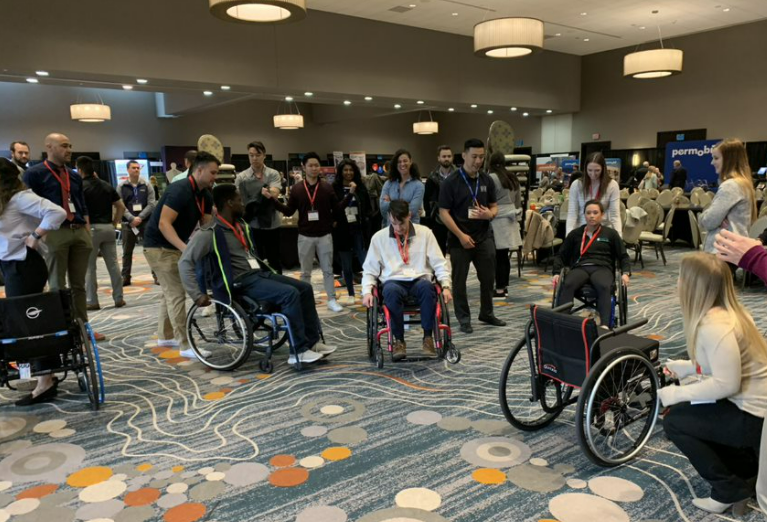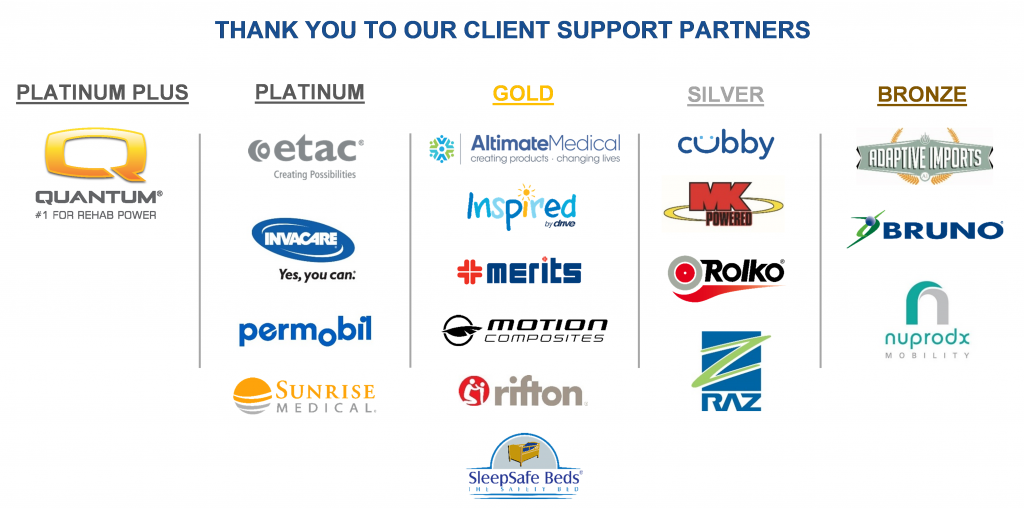HARTFORD MOMENTUM ACADEMY EDUCATION & TECHNOLOGY EXPO
THURSDAY, MAY 2, 2024
Empty heading
Pratt & Whitney Stadium at Rentschler's Field
Hartford, CT
Event Highlights
- Earn up to 6 hours of continuing education (CE) credits for PT, PTA, OT, COTA, ATP
- Network with industry professionals
- Exhibit hall with the latest assistive technology
- Breakfast and lunch provided
The rate is: $69 for up to 6 CE credits

SCHEDULE OF EVENTS
7:00am - 7:45am: Registration
7:45am - 8:00am: Kick-off
8:00am - 12:00pm: Education Courses
12:00pm - 1:00pm: Lunch
1:00pm - 5:00pm: Education Courses
The Supplier Exhibit Hall will be open throughout the day
with 2 hours of unopposed exhibit hall time.
Click here to view full event schedule.
TOPICS
Adaptive Technologies from Birth to Adult
Seating & Positioning
Therapeutic Interventions
Impacts of Wheelchair Configurations
Funding & Documentation Best Practices
ATTENDEES
Physical Therapists
Occupational Therapists
Care Coordinators
Home Health Staff
Group Home Staff
Case Managers
Purchasing Agents
Physicians and Nurses
Continuing Education Courses
Explore the course offerings. You can pick & choose the classes you'd like to attend.
8:00am - 9:00am
Clinically Speaking: The Power of Prevention
0.1 CEUs / 1 hour
Presented by: Jay Doherty, OTR, ATP/SMS
Quantum Rehab
Individuals with chronic medical conditions and long-term disabilities who have a permanent need for a wheelchair require a comprehensive, detailed evaluation of their physical, functional and environmental needs to allow clinicians and ATP suppliers to make appropriate Assistive Technology recommendations for a successful outcome.
This course will examine the clinical decision-making process and algorithmic approach to mobility assistive equipment trial and recommendation. This course will also serve as a review of preventative therapeutic use of powered seating features that allow end user increased independence not only in daily activities but also in the importance of medical management when caregiver and therapy resources may be limited. The use of powered features will be reviewed in regard to management of frequent co-morbidities and medical conditions such as: orthostatic hypotension, edema, contracture/tone management, pressure injury prevention, and the application of positioning components that can aid in decreased the complications of skeletal deformities over time. Many times, end users may be overlooked for their potential of meeting power wheelchair criteria that could provide them increased functional independence and control within their environments and to help be a part of preventing further medical complications. It is known that over 60,000 people in the United States die each year form pressure injuries alone and we know that utilization of pressure re-distribution for those lacking sensation and independent mobility can reduce this by giving the user control of their repositioning.
9:00am - 10:00am
The Case for Wheels: An Overview for Selecting the Clinically Appropriate Power Wheelchair Base
0.1 CEUs / 1 hour
Presented by: Jay Doherty, OTR, ATP/SMS
Quantum Rehab
The recommendation of power wheelchair mobility can be very challenging within the Complex Rehab market these days. There are many different choices for the consumer to choose from. Drive wheel configuration choice can have a major impact on how the wheelchair is utilized and how the power wheelchair functions for the individual. This class will provide the participant with an overview of the information they will need to assist in the selection of the correct power base for the individual’s specific needs.
8:00am - 10:00am
Standing Throughout the Lifespan
0.2 CEUs / 2 hours
Presented by: Maryann Girardi
Altimate Medical
This course will explore the benefits of standing for all ages. The current evidence available and the indications for incorporating a standing program a treatment program. Options for standing technology will be discussed to enable the provider to select the appropriate stander to meet the needs of the user.
Power Assist: Applications to Improve Function
0.1 CEU / 1 hour
Presented by: Heather Cianciolo, OTR/L, ATP/SMS
Permobil
- Identify manual wheelchair riders who may be at risk for repetitive stress injury.
- Differentiate between three different types of power assist.
- Identity how power assist can improve function.
What Factors Really Affect the Efficiency of a Manual Wheelchair?
0.1 CEU / 1 hour
Presented by: Curt Prewitt, MS, PT, ATP
Etac
There are many firmly held opinions about what factors most dramatically affect manual wheelchair propulsion efficiency. Which factors have the greatest impact and are most important to consider? Is it the weight of the chair? Is it the component selection? Like an automobile, is it the way it is tuned or set up that optimizes efficiency?
Prescribing professionals must understand how people use their manual wheelchairs. They must also understand how wheelchairs actually work as a machine. Armed with this knowledge, the professional can make appropriate decisions to optimize efficiency while meeting the user's needs for support, stability, and function.
This presentation will discuss factors commonly considered to be predictors of manual wheelchair propulsion efficiency. We will compare these factors in light of what current research suggests as being predictive and then provide some applicable conclusions to inform clinical practice.
Client Centered Prescription
0.1 CEU / 1 hour
Presented by: Christie Hamstra, PT, MSPT, DPT, ATP
Motion Composites
There are many elements that come into play when prescribing a wheelchair, and it can be difficult to make sure you are truly staying client-centered. This presentation will review the process of a wheelchair prescription while managing the client, therapist, dealer and funding sources interests. We will review therapeutic models and professional standards, which highlight the therapist’s goals and responsibility as well as strategies to manage all priorities and opinions.
Clinical Considerations for Power Mobility Use for Individuals with Cognitive Impairments/CVA
0.1 CEUs / 1 hour
Presented by: Jay Doherty, OTR, ATP/SMS
Quantum Rehab
This course will take time to review the common concerns when considering power mobility utilization for those with cognitive impairments. Evidence based practice will be highlighted in relation to those with stroke or cognitive impairment in regards to proper training, assessment, and potential in the utilization of complex power mobility devices. We will review the common seating and mobility challenges in regards to safe, timely, and efficient manual wheelchair mobility performance and how to optimize utilization of the most appropriate mobility device through proper clinical reasoning. Recommendations on how to best approach mobility trials and training will be described as represented in the literature along with case studies for application.
Power Standing Mobility: Navigating the hurdles surrounding power standing
0.1 CEU / 1 hour
Presented by: Heather Cianciolo, OTR/L, ATP/SMS
Permobil
As humans we are designed to stand; not just stand occasionally; but spend most of our days standing. We stand to work; we stand to perform our daily activities and self-care; and we stand in sometimes to play or socialize. Unfortunately, not everyone gets the luxury of standing and research is beginning to show the negative impact of prolonged seated positions. So why have we been so hesitant to move our patients to power standing mobility? A big reason is the process of obtaining power standing mobility has long been difficult and overwhelming even for the best clinicians and equipment suppliers.
Providing power standing mobility is now taking center stage in the world of CRT as many funding sources are viewing the medical and functional benefit to standing. In this course we will review the benefits of standing both medical and functional, the ongoing cost of sitting, and how to improve delivery of power standing mobility to get the best outcomes for your clients.
Are Adjustable Cushions Better?
0.1 CEUs / 1 hour
Presented by: Curt Prewitt MS PT, ATP
Etac
Many consider adjustable wheelchair cushions to be the ultimate solution for clients at high risk of pressure injuries. However, they may not be fully aware of what defines an adjustable wheelchair cushion, how the technology works, and what it should accomplish when properly constructed, adjusted, and used. Every interaction between an individual and a different cushion is a unique result of those two specific variables at that point in time. Can you know whether a specific adjustable cushion can be properly adjusted for any individual’s seating needs without trialing it first? Further, can you determine the proper adjustment prior to trial? Over time, will the adjustable characteristics of the cushion be able to accommodate changes in clients’ needs? Should a good adjustable cushion offer the adjustment needed to properly fit at initial issue, as well as the ability to adjust as an individual’s needs change?
Unlocking Mobility - Strategies for Optimal Drive Control with Alternative Drive Controls
0.1 CEU / 1 hour
Presented by: Heather Cianciolo, OTR/L, ATP/SMS
Permobil
During this 1-hour CEU, we will discuss for individuals with limited physical abilities, a power mobility device that serves as a gateway to independent movement and environmental control. The success of using such a device, hinges on the user’s connection to it, their ability to operate the power wheelchair effectively, and ultimately, their confidence in achieving their mobility goals. During this course, clinicians and providers will gain valuable insights into evaluating, selecting, and configuring appropriate input devices for functional power wheelchair mobility. We will discuss client-specific factors and clinical considerations that influence drive control choices, exploring both proportional and non-proportional drive systems. Through practical examples and clinical applications, we’ll define essential parameters and discuss terminology relevant to a wide range of commercially available power wheelchairs and alternative drive controls. Actual client case studies will illustrate potential alternative drive solutions to optimize functional outcomes.
Putting It All Together: Translating Evaluation Findings to Configure the K0005 Manual Wheelchair
0.1 CEU / 1 hour
Presented by: Curt Prewitt, MS, PT, ATP
Etac
The seating and mobility evaluation has been completed and a K0005 manual wheelchair has been selected as the appropriate piece of equipment. The make and model of the wheelchair has been determined. Now it is time to fill out the order form. How do you compile all of the information from the subjective interview, physical assessment, and equipment trials to determine the final equipment configuration and set up? How do you ensure that the wheelchair will meet the needs of the user now and allow the potential for adjustments over time? This presentation will use clinical examples to demystify the process of translating clinical findings to final equipment prescription, with particular attention to the complexity of rigid K0005 manual wheelchair configuration. Consideration will be given to changes in health condition/need as a result of circumstances such as: time post injury or illness, disease progression, and age.

